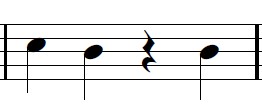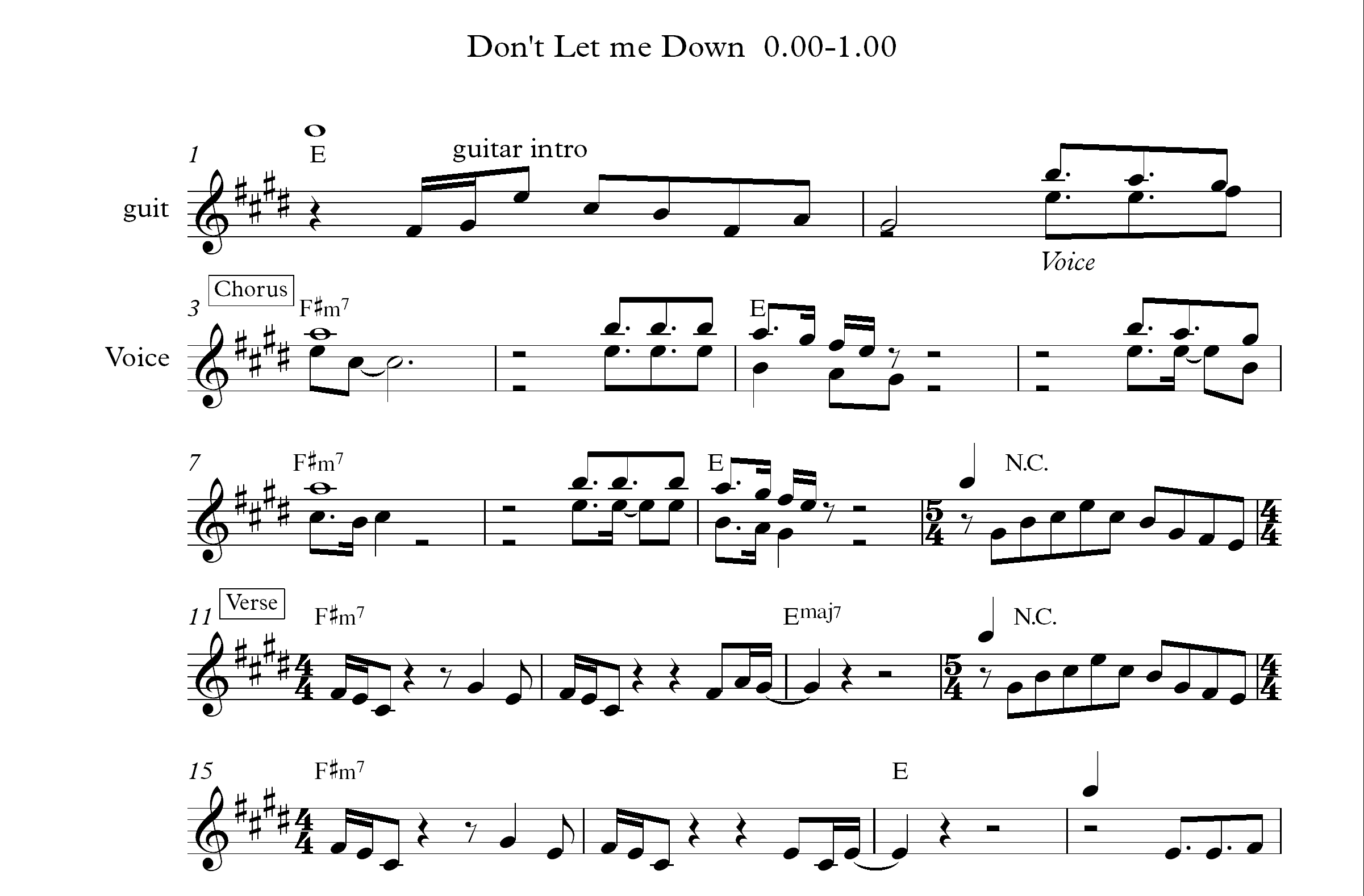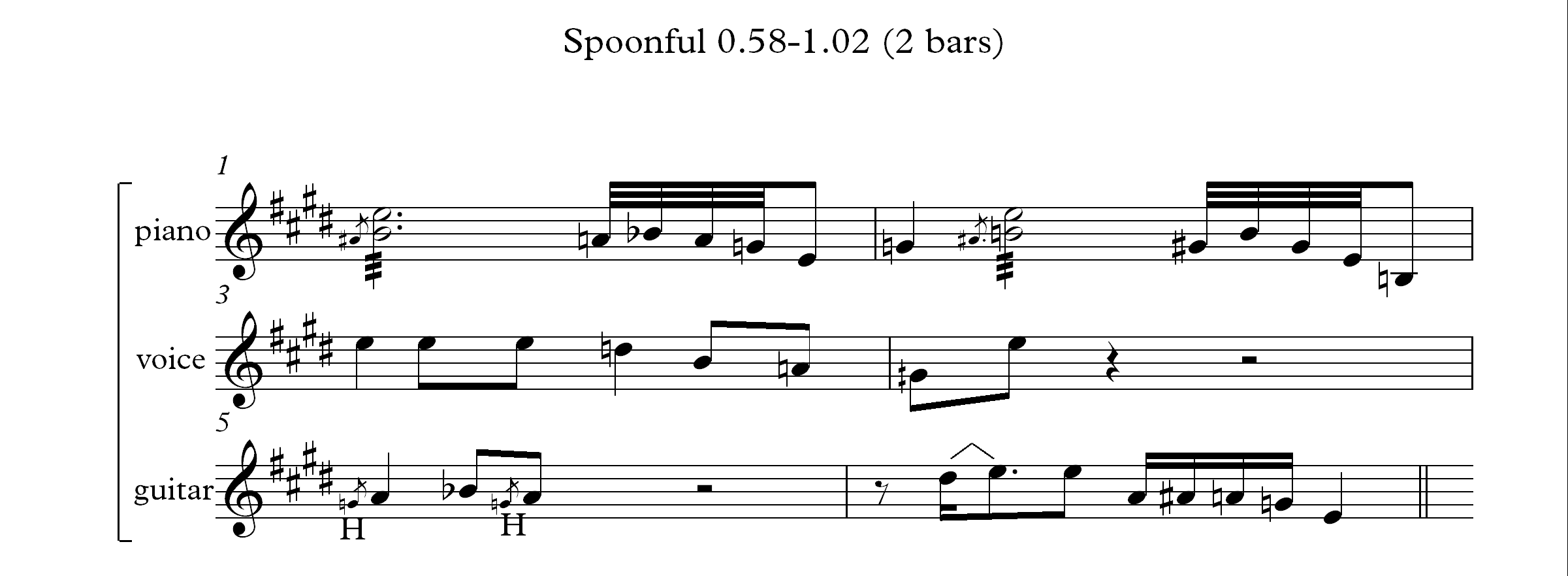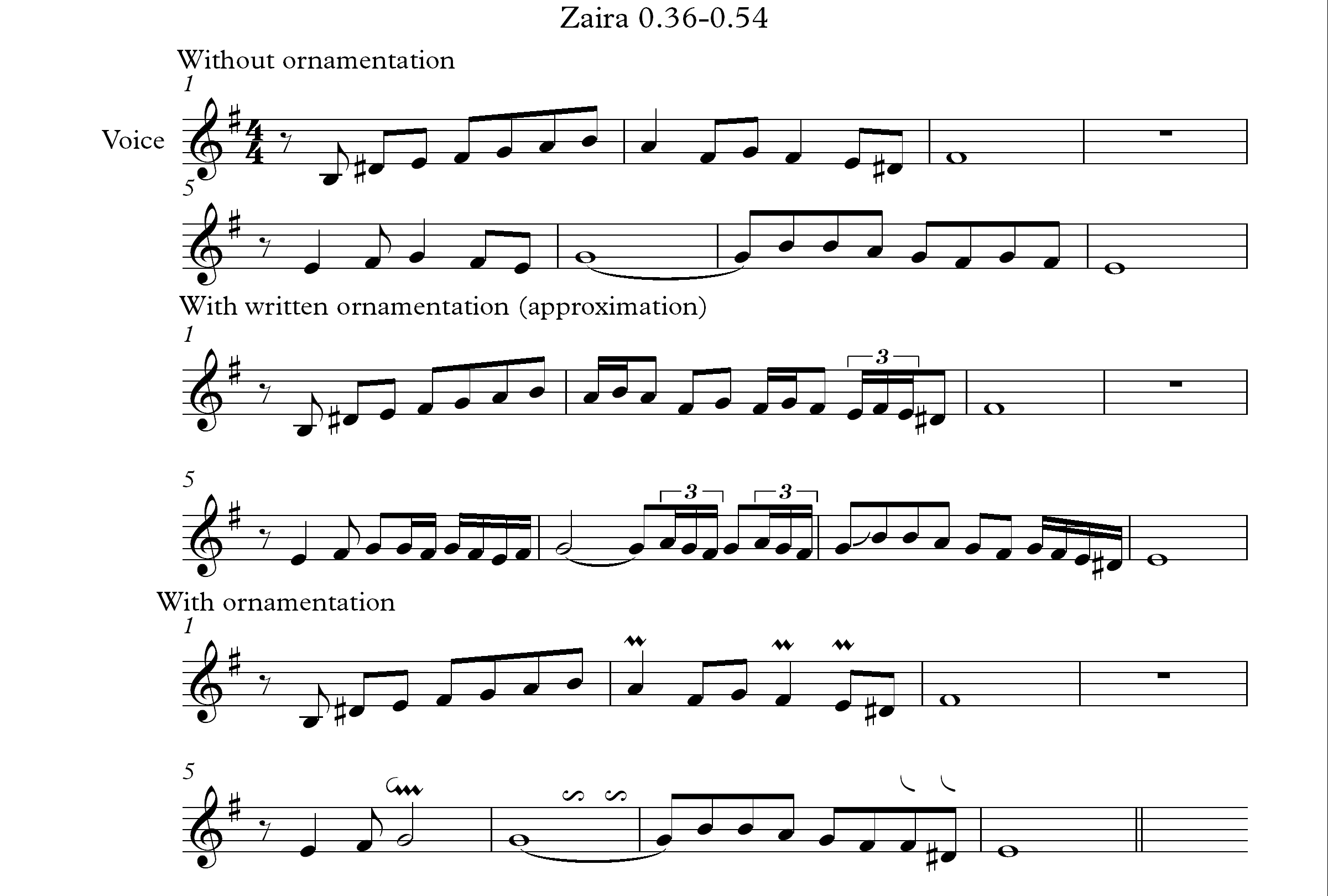Some Obstacles
Lesson goal: become more familiar with the many obstacles in the transcription process and how to overcome some of them.
Up to this point the techniques we have learnt are sufficient for dealing with most pieces of music. However, there are some pieces of music in which a variety of factors such as poor audio quality/mixing/recording, complexity, use of extended musical techniques and tuning make it difficult to transcribe certain elements of the music. They create obstacles that require special attention and sometimes special techniques to overcome. The scope of this lesson is to become familiar with many obstacles and some techniques you will use to overcome them. It is a rather large chapter so I recommend you focus on the obstacles that you find most relevant to the kind of music that you plan on transcribing. We will look at many examples!
We will divide obstacles into classes: melodic, rhythmic, harmonic, other
Melodic obstacles
Melodic obstacles have to do with melody. They come in a variety of forms but usually are dealing with melodic content comprised of pitches outside of our 12-tone equal tempered tuning system. This can arise when singers or instrumentalists use portamento and ‘slide’ gradually between two pitches:
David Wilcox – Do the Bearcat
Pearl Jam – Alive
You have already had a glimpse of this when working on transcribing the vocals and guitar solo from Red Hot Chili Peppers – Californication last lesson.
It can also arise when singers or instrumentalists use ornamentation:
George Zamfir – Mindrele
Maria Ninou & Vassilis Tsitsani – Zaira
Or lastly when a piece of music uses a completely different tuning system:
Lambata Sari Anom
In the case of portamento it is important to first isolate which note the portamento begins and which note it ends on. Does it start and end on a specific pitch? In the case of Do the Bearcat it first starts on E but then it doesn’t really have a specific end point.
However, in Alive both instances of portamento terminate at a note one tone lower than where it started. For this song, after hearing repetitions of the melody without portamento it is much easier to understand the use of portamento as an addition to the basic melody – just a different way to get from one note to another.

If you have troubles hearing start and end points it will help to slow the music using any recommended technology. However there are some cases in which slowing down the music will make vibrato or slightly out of tune singing/playing sound like portamento. If you encounter vibrato treat it the same way we have been treating articulation, that is, you can feel free to ignore it for now. It is important to always listen again at tempo to the piece to determine if these small alterations fit within the framework of the melody and were intentional or not. I encourage you to sing/play the melody with portamento to see when the addition of portamento sounded appropriate. Chances are if you cannot sing it accurately, the portamento was not intentional and is not worthy of transcription.
Demo 7.1 Portamento
When dealing with ornamentation it is crucial that you first understand the melody without ornamentation. In Zaira for example the best way to do this is to isolate each region that uses ornamentation and then try to find one (maybe sometimes 2) note that will best represent the ornament. These notes will never be more than a tone away; so in bar 2 beat 4 of Zaira you can be sure that the E could be replaced with either F#,F,E,D#, or D, nothing else. Play the melody replacing the ornament with each of these neighboring notes one by one and check to see which one sounds right. There should be one obvious choice. Also try to keep the rhythm as simple as you can for now. Once you have found the melody without ornamentation it remains only to figure out what ornament goes where. For each note that you added listen again to the corresponding ornament. Did it start higher, lower or right on the note you chose? Again, everything should be contained in a small range – no 2 notes more than 2 tones away. Where did it end? How does it connect to the next note in the melody? If you are having troubles hearing these details start slowing the music down. Also note that often ornamentation uses notes outside of our tuning system (a little bit sharp or flat) like in Zaira bar 7, so it is best to choose whichever notes most closely represents the ornament and write it that way.
Here is another example where in bar 2 from beat 2 until beat 4, the Romanian nai employs a non-continuous version of protamento again using a pitch somewhere in between B and Bb (~B quarter-flat) on beat 3 and an ornament (vibrato) again involving B quarter-flat and Bb on beat 4. Slowing down the music and isolating sections using loops is the best way to pick up on these subtleties.

Dealing with other tuning systems is outside the scope of this course.
Rhythmic obstacles
Rhythmic obstacles can be as follows: playing behind/ahead of the beat, phrasing, free rhythm, tempo change, time signature change.
Behind the beat:
Art Blakey and the Jazz Messangers – Down Under
Phrasing:
Westlife – The Rose
Free rhythm:
Maria Groseva – Malino Mome
Tempo change + feel change:
Golden Ring Ensemble – Those were the days my friend
Feel change + time signature change:
The Beatles – Don’t Let me Down
Fortunately playing ahead or behind the beat is something for which humans have a high degree of tolerance. Something has to be very behind or very ahead to start sounding wrong to us. In fact, playing a little behind or ahead can, in the right context, be super hip and groovy. In Art Blakey and the Jazz Messangers – Down Under listen to how the trumpet lays behind the beat whilst still locking in with the upbeats on the ride cymbal thus ‘deepening’ the swing and giving a sense of forward momentum.

And so transcribing behind or ahead of the beat playing is not very difficult. The only challenge comes in determining whether someone is playing ahead or behind the beat or if there is something more going on. Like in Tutu where the drums keep a steady beat and do some fills and the trumpet (and the rest of the band in unison) play on the (swung) and of 1. So it is not just playing ahead of the beat, it is playing at a very specific point in the bar. Of course the whole band needs to hit that shot together!

Experience and context are your best guides for distinguishing playing behind or ahead of the beat from rhythmic distinction.
Phrasing (not in the classical sense) is when a musician elaborates on a rhythmical framework. Unlike playing ahead or behind the beat, when someone phrases a melody they will actually change the rhythm of the melody to a different, equally representable rhythm. For some people this comes naturally whilst others not. When you transcribe a piece of music it is important to decide whether or not you will include phrasing into your transcription. If you are to include phrasing it is important that you be as accurate as possible with notating your rhythms whilst keeping in mind music notation conventions. At this level (and in general) you will not usually need to deal with subdivisions smaller than 16th notes. So one thing that you can do to check your transcription is to check every 2nd 16th note ![]() bar by bar because that is usually where complicated phrasing happens. If you decide not to include phrasing, just like when dealing with melodies with ornamentation you will need to create a simpler version of the melody. In the case of The Rose, this amounted to sticking to only 8th note subdivisions.
bar by bar because that is usually where complicated phrasing happens. If you decide not to include phrasing, just like when dealing with melodies with ornamentation you will need to create a simpler version of the melody. In the case of The Rose, this amounted to sticking to only 8th note subdivisions.

When creating a version without phrasing you will often have to choose between 2 pitches. In The Rose bar 2 (not counting the pickup) of the version without phrasing it would also have been suitable for the first quarter note to have been a B instead of a C#.
And you may need to choose between 2 different rhythms. As in bar 6 where the last B in the bar could have been a quarter note or an 8th note and both would have been equally correct.
When dealing with free rhythm and add lib performances, it is important to first off be sure that your piece does not have rhythm. Make sure that you have tried a variety of time signatures before concluding that it does not have rhythm. If the piece in free rhythm you can notate it without barlines.
Malinoe Mome
Tempo changes are usually rather obvious and it is your choice when to deem them significant.
Audio 7.9.1
Harder to detect are changes in time signature and/or feel. When there is a change in time signature do check whether there is a change in pulse. In the case of Suspicious Minds the pulse does not change.
One way to check whether the pulse changes or not is to clap along to the recording. It is often helpful to tap along (on the drum) using the sound corset and tuner app and at the instance when the time changes let the metronome continue and then judge for yourself whether it is in sync with the new section. Also note that Suspicious Minds could have stayed in 4/4 time for the bridge and instead employed a triplet feel. This is an alternate way of notating the same thing. A similar thing happens in Those were the days between the first chorus and the 2nd verse. Where the song moves to a 12/8 feel.
Audio 7.9.2

However there is no metric modulation so the 12/8 should feel slower than in Suspicious Minds comparatively speaking. When a piece has a change of time signature, make sure to check whether there is a relation between the two sections. One final approach to doing this is to calculate the tempi of each section and then compare them later to see what relationship they have. For example in Suspicious Minds the relationship would be 1:1 and in Those Were the Days 2:3.
If the performance is add lib it is often still based on a rhythmic framework. In the case of Those were the Days both the first and last verses are add lib. However, they are based on the same rhythmical framework as the 2nd verse which is for the most part in time. It is important to be able to follow along to the add lib sections. You should have a feel for when a chord will change base on which note the singer/lead instrumentalist is playing. As a hint for determining a rhythmical framework, you will often hear add lib sections repeated in time later on in the piece.
Sometimes you will need to change time signatures for one measure in a piece. It is very common for a piece to add/remove one or two beats to accommodate a pickup or prolong/expedite the arrival to the chorus. Not only can this create a sense of rhythmic illusion, but it also helps drive the song forward. It is important to clearly determine the start and end points of each section and then you can determine where to insert the time signature change. Sometimes ‘listening backwards’ (continuously restarting listening to the song from a time point progressively further back) will help with this.
Demo 7.2 Listening Backwards
In Don’t let me Down there is a measure of 5/4 to accommodate the vocal pickup. Alongside this the chorus has a different feel/groove than the verse and is based on this rhythm: ![]()

Upon deciding to change the time signature, make sure you are sure how many beats the bar should be. Count along to the song and determine what would be the best choice. Again, make sure you have a clear idea of when each section of music starts and ends. Make sure that you are consistent. FYI it is common for pop and rock songs to include half-measures (bars of 2/4 in 4/4 songs).
Harmonic obstacles
Up to this point we have been dealing with music with simple, well-defined harmony. But not all music is like this. Some (not all) obstacles you will (and actually already have) face when dealing with harmony are: chords in inversion, harmonies with more than 3 notes, harmonic ambiguity, modal harmony, and modulation.
Harmonic ambiguity:
Howlin Wolf – Spoonful
Chords in inversion:
Elvis Presley – Can’t help falling in love
Harmonies with more than 3 notes + modulation:
Ella Fitzgerald – Body and Soul
Modal harmony + modulation:
Tea Party – Halcyon Days
When talking about harmony it is important to apply a rather robust definition. It is important to think about harmony as being any other pitches that are not the melody. With this outlook on harmony certain situations can be more easily understood. A chord no longer remains an object (a group of notes) but rather a concept or guideline for a particular moment in a piece of music. A Dmaj7 may mean different things depending on what context it is written. For a jazz song it may mean play notes from the D Lydian scale where as in a pop setting it is more often referring more concretely to D F# A and C#. In this sense, deciding which chord symbol to use in a transcription can be at times difficult. For ex. In Spoonful, at many points in the song there is harmonic ambiguity. Although the piece stays pretty much on one chord the whole time it is very difficult to say what that chord is. In two bars alone the pianist plays G G# Bb and B, the guitarist plays G and Bb along with some hammer-ons that pass through G#, and finally the singer sings B and something in-between G and G# (very bluesy!). So each of Edim, E, E7, Em, Em7 are all correct in some regard and it is impossible to decide which one to use.

From this example we see that it is important not to rely solely on chord symbols to express a harmonic setting and in doing so a lot of subtle harmonies and sonic spaces are neglected. On the other hand there comes a time in which representation of harmony using simpler chord symbols is more fitting. In Body and Soul bar 8 (of the second A) based on what the pianist and bassist are playing one could write 4 chords G6 Bm7/D Eb13 Eb7sus but there is no reason to do so. It just happened that those harmonies where created when both the bassist and pianist were realize the simpler 2 chord version of the bar G Eb13.

With the idea that a chord symbol is a guideline for how to present a certain harmony, it is best to keep the chord symbols simple and only include more detailed chord symbols if they are necessary and significant. With this in mind, when transcribing music that has harmonies with more than 3 notes it is best to first express all the harmony using only triads, then seventh chords (or 6 chords in some cases) and then later try to understand more specifically what the rest of the notes (extensions) in each chord are. This won’t work for all harmonies like quartals, clusters, phrygian chords etc., but it will work well for most music, especially straight-ahead jazz. Knowledge in music theory will also help in making deductions about additional notes in chords.
Another situation in which chord symbols are rendered insufficient for expressing a harmonic setting is in modal music. In the same way spoonful was in this sort of mixolydian#9#11 mode other pieces can be in other modes. Halcyon days starts out in F# Phrygian major mode (flamenco mode) and then modulates directly to B mixolydian and alternates between these two modes. In this case it is best to understand the harmony as resultant of the various melodies in the music. The piece was likely conceived not as a 1 chord chord progression but as alternating from one mode to another. So in this case it is best to write the mode/scale instead of a chord.

Since you already know how to transcribe basslines, dealing with chords in inversion and chords that are qualities other than major or minor should be easier now. If you are stuck on a certain chord and finesse is getting you nowhere you can try this exhaustive search procedure:
i) determine the bass note
ii) based on what quality you think the chord is try all chords of that quality that contain the bass note. So if you think the chord is major and your bass note is A. Try A major F major and D major.
iii) try ii) again with a different quality (if your quality was major try minor, diminished, augmented, Maj7, m7, dim7, halfdim 7)
Notice how in Can’t Help Falling in love knowing the bassline makes finding the chords much easier; this chord progression based on the descending major scale bassline is very common.

Also the more music theory you know the easier it will be to identify chords that are outside of the key of your piece. Once you start learning (or have learnt) about things like augmented 6th chords, secondary dominants, passing diminished chords, modal mixture etc… you can try them first to more quickly refine your search.
Modulation is easy to deal with: just learn both sections like 2 different songs. Afterwards try to figure out what chords (if any) are used to connect the two sections if any. Again music theory will be helpful here.
Other obstacles
Some other obstacles you may run into when having to transcribe a piece of music are:
out of tune recordings
very poor audio quality
‘inadequate’ musical performance
unfamiliar techniques/instrumentation
For most of these obstacles there is no real workaround. For poor audio quality you could try filtering out any frequencies that contribute to noise in the track using technology (audio filtering). When dealing with ‘inadequate’ musical performances make sure that you are correct in your judgment of the performance. It will often be the case that a performance is intentionally sloppy or dissonant. But there are times in which the performers just aren’t doing justice to the song. Like two guitar players strumming completely different chords, a singer singing the melody in a different key etc… usually these instances are obvious to the musician and non-musician alike. In such a case if it is mandatory that you learn that tune (for a band or project that you are in) I recommend discussing the issues with the artistic director before going on to try to decipher what nonsense is happening musically. When you come across a sound that you have not heard before it is probably either an instrument or synthesized sound you are not aware of (like say the double contrabass flute for example) or an extended technique on an instrument you likely are aware of like col legno, nails scrapping the lower strings of a piano, guitar strumming on the other side of the bridge etc… The best way to understand what sound you are hearing is to research the track in question and become more familiar with extended techniques for that track’s instrumentation. When dealing with pieces with a lot of in the box production (reverb, delay, compression, panning, track doubling just to name a few) this can be particularly difficult and can require extensive knowledge in audio production to even get started with understanding some of the sounds.
The only one of these obstacles that we do have a clear solution to is out of tune recordings. Often in an effort to avoid been caught for copyright infringement, people will upload altered recordings of well known pieces of music to youtube. They will change the speed or the pitch or both of a recording. Often this will result in recordings that are out of tune. And by out of tune I mean that they are not in say E major or F major, but somewhere in-between. So not in standard A 440 tuning (but still in 12TET). In such cases finding the key of the piece of music is very difficult. This issue has 2 solutions:
(if you have perfect pitch opt for the second option)
1. Change the pitch of your instrument. If you have a keyboard that has a tuning function you can use that. Guitarists, you can physically tune your guitar.
2. Change the pitch of the recording.
Demo 7.3 Out of Tune Recordings
I know that for some of these obstacles we went into great detail and that is because I want to give you at least a starting point in the case that you are interested in music regularly involving these obstacles such as dense harmony in Jazz music, portamento in Romanian folk music, changing time signatures and feels in prog rock etc…
Assignment 7.1
1) Transcribe the bassguitar and the harmony(chord chart) in Another Day – McCarntey (0.28 – 2.08 (end of 3rd verse)) Assignment 7.1.1
2) Transcribe the vocal melody and the harmony to the add lib intro to Joe Cocker – Unchain My Heart. Assignment 7.1.2
3) Write a chord chart for the first verse and chorus of Outcast – Hey Ya Assignment 7.1.3
Careful the chords in the verse are not exactly the same as the chorus.
4) Transcribe synth intro (0.00-0.07) then voice and bass (0.07-0.33) in Sheck Wes – Mo Bamba (0.00-0.33) EXPLICIT LANGUAGE NOT SUITABLE FOR ALL AGES Assignment 7.1.4
5) Transcribe the vocal melody of the first 30 seconds of Righteous Brothers – Unchained Melody. Make a simplified version without as many ornaments in which it is easier to see the melodic framework. Assignment 7.1.5






